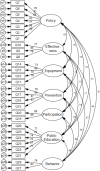Psychometric properties of public trust in Covid-19 control and prevention policies questionnaire
- PMID: 36280814
- PMCID: PMC9589749
- DOI: 10.1186/s12889-022-14272-9
Psychometric properties of public trust in Covid-19 control and prevention policies questionnaire
Abstract
Background: Public trust is a crucial concept in the COVID-19 pandemic, which determines public adherence with preventive rules as a success factor for disease management. This study aimed to develop and validate a tool to measure public trust in COVID-19 control and prevention policies (COV-Trust tool).
Methods: This is a psychometric study that was conducted in 2020 (March-August). A primary tool was developed through literature review, in-depth interviews with experts and expert panel meetings. Content and construct validity was evaluated using content validity index (CVI) and content validity ratio (CVR) indexes and exploratory and confirmatory factor analysis, respectively. Cronbach α coefficient was calculated to determine the internal consistency.
Results: A 28-item questionnaire with seven factors was developed. Factors included macro policy-making and management of pandemic, pandemic control policies implementing at all levels and their effectiveness, providing protective equipment and medicine for hospitals and public, prevention of negative socio-economic consequences of the pandemic, public participation, informing and public education and public behavior. The questionnaire reliability was calculated to be α = 0.959. Based on the experts' opinion, tool content validity was estimated to be CVR = 0.73, CVI = 0.89. RMSEA = 0.07 revealed a good model fit as the confirmatory factor analysis results for the tool.
Conclusion: COV-Trust tool is a well-fit tool to be used during this pandemic for improving policies effectiveness and could be used in similar situations as it determines the success of public health interventions.
Keywords: COVID-19; Management; Policy; Prevention; Trust.
© 2022. The Author(s).
Conflict of interest statement
Declared none.
Figures
Similar articles
-
Development, validity and reliability study of a compliance scale for the COVID-19 outbreak prevention recommendations.Turk J Med Sci. 2021 Jun 28;51(3):898-911. doi: 10.3906/sag-2005-243. Turk J Med Sci. 2021. PMID: 33306335
-
Development and psychometric testing of the Knowledge, Attitudes and Practices (KAP) questionnaire among student Tuberculosis (TB) Patients (STBP-KAPQ) in China.BMC Infect Dis. 2018 May 8;18(1):213. doi: 10.1186/s12879-018-3122-9. BMC Infect Dis. 2018. PMID: 29739363 Free PMC article.
-
Psychometric properties of primary health care trust questionnaire.BMC Health Serv Res. 2019 Jul 19;19(1):502. doi: 10.1186/s12913-019-4340-6. BMC Health Serv Res. 2019. PMID: 31324170 Free PMC article.
-
Development and validation of the COVID-19 Impact Scale in Australia.Curr Med Res Opin. 2023 Oct;39(10):1341-1354. doi: 10.1080/03007995.2023.2247323. Epub 2023 Sep 7. Curr Med Res Opin. 2023. PMID: 37656161 Review.
-
Developing, translating, and validating a survey instrument for assessing hospital food service staff's food safety knowledge, perceptions, and practices during the COVID-19 pandemic.Saudi Med J. 2024 Jan;45(1):98-103. doi: 10.15537/smj.2024.45.1.20230272. Saudi Med J. 2024. PMID: 38220233 Free PMC article. Review.
Cited by
-
Trust in Medicine: A Scoping Review of the Instruments Designed to Measure Trust in Medical Care Studies.J Caring Sci. 2024 Jan 13;13(2):116-137. doi: 10.34172/jcs.33152. eCollection 2024 Jul. J Caring Sci. 2024. PMID: 39318733 Free PMC article.
References
-
- World Health Organization. Novel Coronavirus (2019-nCoV): situation report, 3. 2020.
-
- Nouri M, Ghaffarifar S, Sadeghi Bazargani H, Ghaffari R. Patients’ Satisfaction with Medical Residents’Communication Skills at the Largest Teaching and Treatment Center in North West Iran in 2016. Shiraz E-Med J. 2017;18(4):e60032.
Publication types
MeSH terms
LinkOut - more resources
Full Text Sources
Medical


